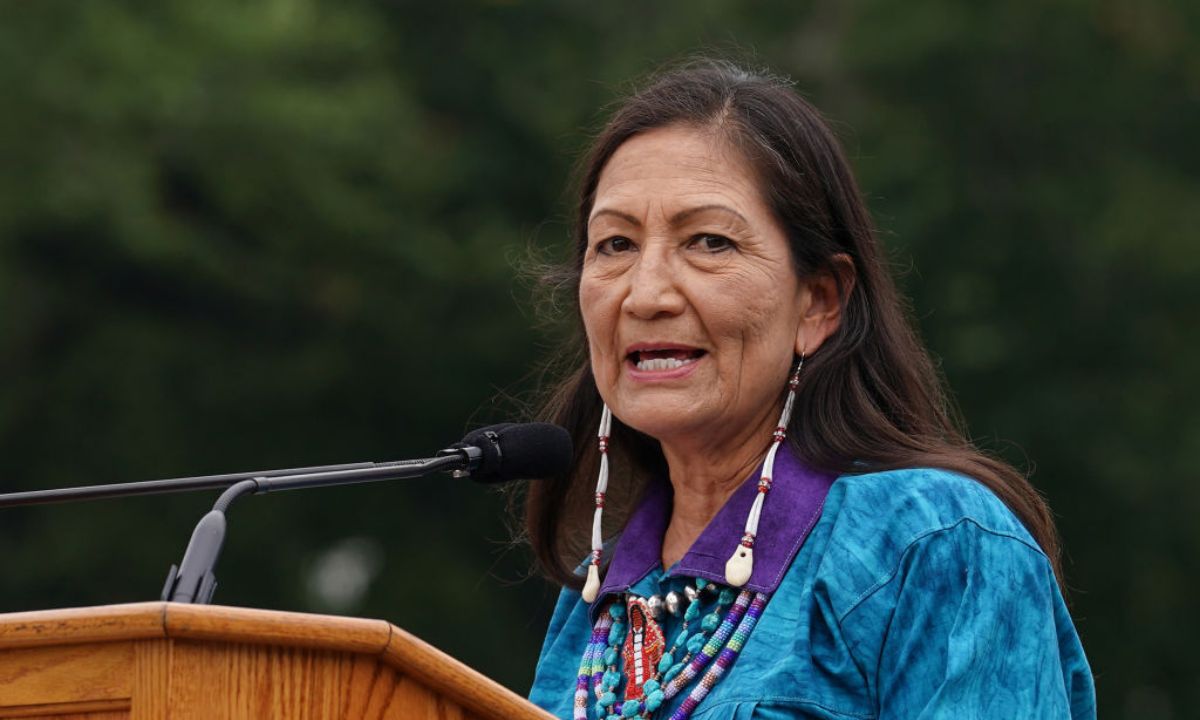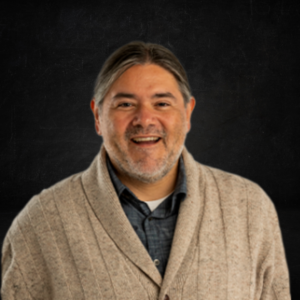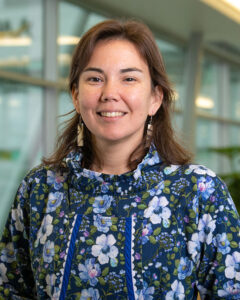Federal Policy Protecting Native Youth From Unjust Family Separation is on Trial
Potential SCOTUS rollback of protected status of Native children — still disproportionately in foster care — would be “twisted,” legal advocates say

Get stories like this delivered straight to your inbox. Sign up for The 74 Newsletter
An adoption case now being weighed by the U.S. Supreme Court could roll back measures designed to protect American Indian children from being taken from their families — a process frequently initiated in schools.
On Nov. 9, the court heard oral arguments in Haaland v. Brackeen, which pits three non-Native families and the state of Texas against four federally recognized Native tribes and the U.S. government. The families seek to reverse a clause of the 1978 Indian Child Welfare Act preferencing kin and tribal members in the adoption of Native children, arguing it discriminates against non-Native families on the basis of race.
Tribal communities fear the case puts the landmark law commonly known as ICWA in jeopardy, and with it, key provisions designed to protect Native youth from unjust family separation. Nearly 500 tribes, 87 members of Congress, 23 states, along with several Indigenous and child welfare organizations, have signed amicus briefs in support of the government’s case, led by U.S. Secretary of the Interior Deb Haaland, who is a Laguna Pueblo tribal member.
Nationwide, Native youth are already among those most likely to be placed in out-of-home care and are involved in the foster system at two-and-a-half times the rate of white children, with school often being the focal point for intervention by child protective services.
It’s “horribly ironic and twisted,” said University of Michigan law professor Matthew Fletcher, that Native families could soon face a loss of protections when, in his view, they need more. Fletcher is a member of the Grand Traverse Band of Ottawa and Chippewa Indians.

Family separations often begin because educators, who are required by law to flag abuse or neglect, report suspected maltreatment. In Alaska and Minnesota, more school-aged Native children are investigated by child protective services due to calls from school staff than from any other group of mandated reporters. In Alaska, educators make abuse or neglect allegations roughly five times as often for Native school-aged children as for those who are white; in Minnesota, they do so at approximately eight times the rate.
“We have deputized teachers to be the eyes and ears of the family policing system,” said Rutgers University sociologist Frank Edwards, who authored a recent paper on the topic. “For Indigenous children, we see this play out to devastating consequences.”
Even when Native kids would be better off staying at home, investigations often conclude that removal is necessary, Fletcher said.
“There’s still an enormous amount of bias. A lot of Native people are poor, they’re brown-skinned, they have different cultural leanings. And almost all social workers are white and more privileged,” he said.
Nationwide, the vast majority of child welfare investigations involve low-income parents of color. Some 80% charge neglect, which lawyers caution can be an amorphous allegation prone to case workers’ subjective judgements.
In New York City, the nation’s largest school district, a previous investigation by The 74 found school staff sent over 13,750 unsubstantiated reports of maltreatment over the span of a year and a half, often plunging families’ lives into invasive and sometimes traumatic investigations. Less than 1 in 3 teacher calls yielded any evidence of wrongdoing.
Across the country, K-12 workers are the most likely mandated reporters to flag abuse or neglect and the least likely to have their allegations find evidence of wrongdoing, data show.
ICWA was passed by Congress to keep American Indian families together whenever possible at a time when as many as 1 in 3 Native kids were being taken from their parents. In addition to preferencing kin and tribal members in the adoption of American Indian children, it also requires an expert witness in Family Court proceedings and allows tribes to intervene in cases on behalf of Native children, giving them the power to transfer the proceedings to tribal court.
“If ICWA goes, I expect a dramatic increase in the number of Native children going into foster care,” Edwards said.
The adoptive families’ lawyer, Matthew McGill, acknowledged that the “history of unjustified breakups of Native families was a terrible injustice.” But reversing ICWA’s adoption placement preferences would not impact the number of Native kids in out-of-home care because the rules “come into play only after a child already has appropriately entered the foster care system,” he said.
The attorney added it would “not be appropriate” to speculate on whether the ruling might impact other ICWA provisions designed to curb Native family separation.
Reversing the harm
The law’s provisions sought to correct nearly two centuries of government policy erasing Native cultures by removing children from tribal communities — tactics that tribal advocates say fall within the United Nations’ definition of genocide.
From the early 1800s to late 1960s, tens of thousands of Native youth were taken from their homes and forced to attend federally sponsored boarding schools, brutal and sometimes deadly institutions where students were forced to use English names, wear Americanized haircuts and perform military drills.
As those schools shut down, officials pushed another assimilation tactic. In the 1960s and 1970s, roughly 1 in 3 tribal kids were put into foster care or adopted — 90% of the time by non-Native families.

“[ICWA] is trying to reverse the harm of boarding school, of child removals and saying we have to make active efforts to … keep a child connected to their family, their community and their culture,” said Jessica Saniġaq Ullrich, a social work professor at the University of Alaska Anchorage.
“You try to maintain them within their culture,” added her colleague, professor Yvonne Elder Chase. “ It’s not rocket science. It’s good casework.”
In Ullrich’s home state, Alaska Native and American Indian children still make up roughly two-thirds of all children in out-of-home care despite representing only a fifth of the state’s overall youth population.
“It’s been disproportionate like that for years,” said the Inupiaq tribal member of the Nome Eskimo Community. “These are families, these are communities, these are future generations affected.”
When child welfare proceedings under ICWA are transferred to tribal courts, she said, outcomes tend to be better. Judges have a level of “kinship” with families and work with them to address issues like food insecurity or unstable housing rather than separating children from parents.
“Tribes are not in the business of punishing poor people because they’re struggling,” Fletcher added.
It’s an approach to child welfare that experts outside of tribal communities also recommend, calling for care-based responses over punitive ones in instances where children are not being intentionally abused. On Nov. 17, the ACLU and Human Rights Watch released a 146-page report titled “If I Wasn’t Poor, I Wouldn’t Be Unfit” on what the organizations called the “family separation crisis.”
Trauma in schools
Schools can be a site of ongoing trauma for Native children. In light of the ICWA case, Kimberly Cluff, who is non-Native, recalled a case she litigated two decades ago in which she represented a tribal family in California’s Central Valley. The son had been required to shave his head by school administrators due to a lice outbreak on campus. But in his culture, hair was sacred and only to be cut on specific occasions, usually after the loss of a loved one, so the family refused. Rather than finding a compromise, the school reported the family to child protective services for educational neglect.
“This child could have easily been taken from his family,” said Cluff, who was a staff attorney at California Indian Legal Services at the time.
Instead, the tribal representation and expert witness allowed under ICWA helped the family successfully argue that they were simply following their customs and not neglecting their child.
Still, the process of being investigated by child protective services can be highly traumatizing even when no evidence of maltreatment is ultimately found, impacted families say. For the evaluations, case workers typically open cabinets and refrigerators to check for adequate food and can ask children to strip down to their underwear to check for bruises.
When those investigations lead to their most drastic results, separating children from their parents, those youth go on to face elevated risks of mental health challenges, incarceration and even early death.
Child welfare threats aside, Native students routinely find that their culture — and very existence — are erased in school curricula, Ullrich observed.
“If it’s only a celebration of Columbus Day [in school] and this colonial view, then there’s a whole population of people that are sitting in those classrooms hearing this history and feeling like they’re invisible and that they don’t matter,” she said.
Gorsuch could be pivotal
Cluff, the California attorney, was in Washington, D.C. for oral arguments earlier this month, assisting tribal leaders from the Morongo Band of Mission Indians with preparing their arguments. It’s a “fool’s errand,” she said, to try to predict how the justices will rule.
Broadly, however, there are a few ways the case could fall, she explained. If the justices side with the adoptive families under equal protection grounds, saying that Native families cannot be preferenced in adoption because doing so amounts to racial discrimination against non-Natives, it would reverse centuries of precedent considering tribal status a political identification rather than a racial one. Such a ruling could possibly undermine Native sovereignty itself.
Short of that, in what Cluff called the “lesser bad outcome,” the justices could carve out individual provisions of ICWA for reversal, saying certain parts of the policy represent federal overreach.
During oral arguments, Justice Neil Gorsuch signaled skepticism toward the contention that the federal government overstepped its powers. The conservative justice spent years working in the Western U.S. where reservation land is vast. He is considered a pivotal vote, having broken with his colleagues in the past on issues related to Native rights.
“Is there some irony in your position that you’re here to vindicate state’s rights?” Gorsuch asked McGill, the families’ lawyer. “We have 23 states who’ve lined up on the other side, and we’ve never had a state court near as I can tell, in the 40 some years since ICWA was adopted, complaining about this arrangement.”
There was not as much discussion about equal protection and the question of race, which two lower courts included alongside the issue of federal overreach in their rulings finding certain ICWA provisions were unconstitutional.
The Supreme Court is expected to issue a ruling in June 2023.
Get stories like these delivered straight to your inbox. Sign up for The 74 Newsletter

;)
